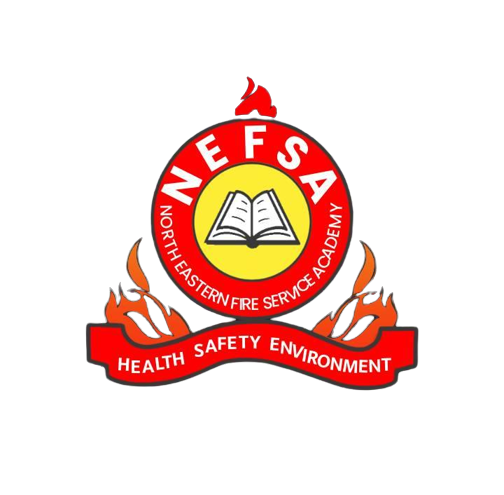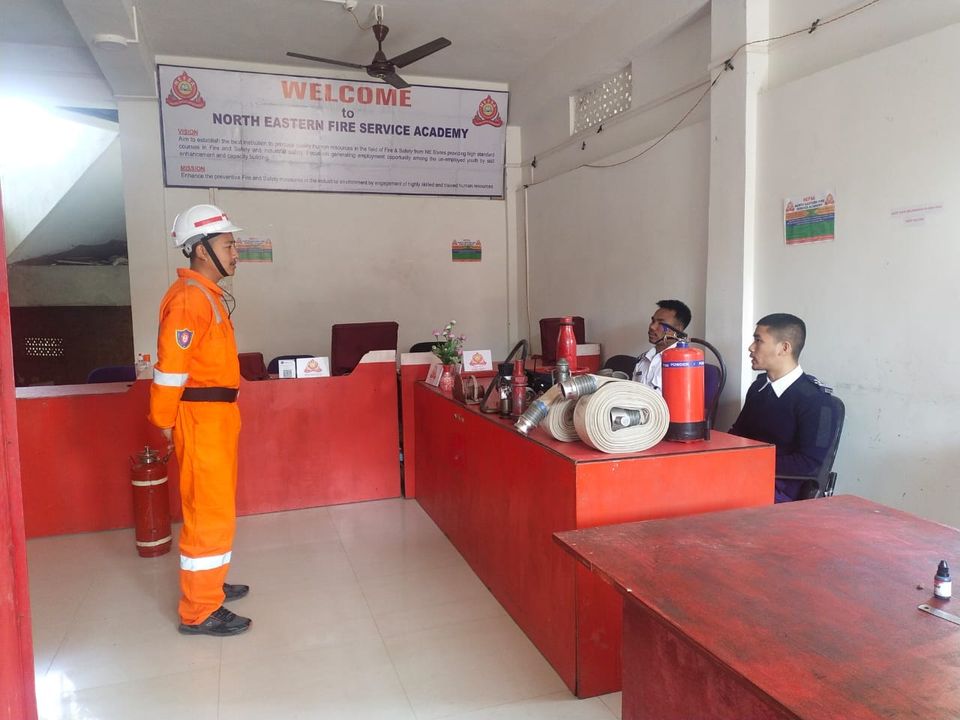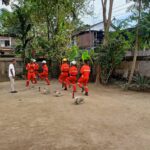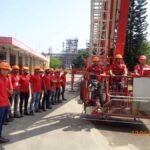Firefighting is an essential and demanding profession that requires specialized skills, quick thinking and above all, the right tools
and equipment. Having access to the best firefighting tools can mean the difference between life and death in emergency situations.
NEFSA Fire Academy, Dibrugarh provides students with in-depth knowledge of the necessary firefighting tools and equipment, ensuring
they are optimally prepared to handle any fire emergency with confidence and expertise.
In this blog, we will explore the key tools and equipment that every firefighter must be proficient in and how NEFSA provides the
hands-on training needed to use them proficiently.
1. Firefighting Helmets and Protective Gear
One of the most essential pieces of equipment in firefighting is personal protective equipment (PPE). A firefighter’s
gear is designed to protect against extreme heat, falling debris, and hazardous materials. The most important components include:
- Helmet: Protects the head from falling objects and extreme heat.
- Turnout Jacket and Pants: Fire-resistant clothing designed to provide thermal protection.
- Fire Boots: Heat-resistant, steel-toe boots that offer protection against debris and sharp objects.
- Gloves and Masks: Gloves protect hands from heat and sharp materials, while masks and self-contained
breathing apparatus (SCBA) ensure clean air in smoke-filled environments.
At NEFSA, students receive detailed training on donning and doffing firefighting gear quickly and correctly, a critical skill when
seconds count.
2. Fire Hose and Nozzle Systems
The fire hose is the most iconic tool of a firefighter’s arsenal. Fire hoses are used to deliver high-pressure water
or foam to extinguish fires, and understanding how to handle and operate them efficiently is essential.
- Hose Types: There are different hoses for specific situations—attack hoses (used to fight the fire
directly) and supply hoses (to deliver water from hydrants). - Nozzles: Nozzles control the flow and pressure of water, allowing firefighters to adjust the spray pattern
for various fire conditions.
At NEFSA, students undergo rigorous hands-on training to understand different hose systems, how to connect them properly, and how to maintain steady water pressure while fighting fires.
3. Fire Extinguishers
Fire extinguishers are one of the most widely used tools for managing small fires. There are multiple types of extinguishers, and
each is designed to fight a specific class of fire:
- Class A: For common combustibles like wood, paper, and cloth.
- Class B: For flammable liquids like gasoline and oil.
- Class C: For electrical fires.
- Class D: For combustible metals.
- Class K: For kitchen fires involving cooking oils.
Understanding when and how to use the right type of extinguisher is a vital part of NEFSA’s training curriculum, ensuring that
students can handle fires at their earliest stages.
4. Thermal Imaging Cameras (TICs)
Thermal imaging cameras allow firefighters to see through smoke and darkness by detecting heat sources. These cameras are extremely
useful in search and rescue operations, as they help locate victims trapped in a burning building.
NEFSA teaches its students how to effectively use thermal imaging cameras to navigate hazardous environments and ensure no one is
left behind during a rescue mission.
5. Fire Axes and Halligan Bars
Firefighters often need to force entry into burning buildings to rescue victims or access the fire. Fire axes and
halligan bars are standard tools used for this purpose.
- Fire Axe: Used to break through doors, walls, or roofs to gain entry.
- Halligan Bar: A multi-purpose tool that combines a pry bar, spike, and adze, used for breaching and
forcing doors.
Students at NEFSA are trained in proper breaching techniques, ensuring they can access dangerous areas swiftly and safely during an emergency.
6. Ladders
Fire ladders are essential for accessing high places, whether rescuing people from upper floors or reaching hard-to-reach parts of a burning structure. Ladders come in a variety of lengths and types, including extension ladders and roof ladders.
NEFSA’s hands-on training includes understanding ladder operation, correct positioning, and how to quickly and efficiently transport
and position a ladder under pressure.
7. Self-Contained Breathing Apparatus (SCBA)
Self-contained breathing apparatus (SCBA) provides firefighters with a source of breathable air in environments filled with smoke,
toxic fumes, or oxygen-deficient atmospheres. The equipment consists of a cylinder, mask, and pressure regulator, allowing firefighters
to work in hazardous conditions without the risk of smoke inhalation or suffocation.
At NEFSA, students receive specialized training in how to wear and use SCBAs, as well as the importance of regular maintenance
and refilling of cylinders.
8. Firefighting Foam Systems
In some types of fires, particularly flammable liquid fires (Class B), water alone may not be effective. Foam is used to extinguish
the fire and prevent it from reigniting by cutting off the oxygen supply. Foam systems are particularly useful in industrial
environments, such as refineries or chemical plants.
The NEFSA training program includes in-depth knowledge of foam systems and their applications, ensuring that trainees are prepared
to deal with any fire, regardless of the cause.
9. Rescue Tools (Jaws of Life)
In the event of a traffic accident or building collapse, firefighters may be called upon to rescue people trapped in vehicles or
under debris. Rescue Jaws, a hydraulic rescue tool, are designed to cut, spread and lift heavy objects, allowing rescuers to quickly
and safely free victims.
NEFSA provides hands-on training in rescue jaws and other rescue equipment, helping students develop the skills needed for complex
rescue operations.
10. Communication Devices
Clear and reliable communication is essential in firefighting operations. Two-way radios and other communication devices allow
firefighters to coordinate efforts, share important information, and call for assistance if needed.
NEFSA emphasizes the importance of communication in firefighting and trains students to use radio equipment to maintain clear
lines of communication in chaotic and dangerous situations.
Conclusion:
At NEFSA Fire Academy, we believe that knowledge of essential firefighting tools and equipment is the foundation for a successful firefighting career. Through comprehensive and hands-on training, students will gain the specialist knowledge needed to effectively
use these tools in real-world situations. Whether you are just starting out or looking to improve your firefighting skills, NEFSA
has the training and resources to prepare you for any challenge.
Our experienced instructors, state-of-the-art equipment and commitment to excellence ensure that each graduate is prepared to
respond to emergencies with confidence and competence. Ready to build your career in fire safety? Enroll in the NEFSA Fire Academy
today and equip yourself with the tools and skills that can save lives.
For more Blog : Click Here







